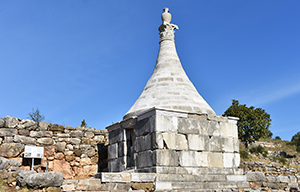Το Ταφικό Μνημείο Κ3
στο Γυμνάσιο της αρχαίας Μεσσήνης
Πέτρος Θέμελης
Διευθυντής Ανασκαφών Αρχαίας Μεσσήνης, τ. Καθηγητής Κλασικής Αρχαιολογίας, Τμήμα Ιστορίας & Αρχαιολογίας, Πανεπιστήμιο Κρήτης
 Το ταφικό μνημείο Κ3, στο Γυμνάσιο της αρχαίας Μεσσήνης, με τους οκτώ κιβωτιόσχημους τάφους στον θάλαμό του, κατασκευάστηκε κατά το πρώτο τέταρτο του 3ου αι. π.Χ. για να δεχθεί τα σώματα οκτώ αφηρωϊσμένων νεκρών μιας μεγάλης και ισχυρής οικονομικά και πολιτικά οικογένειας της μεσσηνιακής ελίτ, τριών γυναικών και πέντε ανδρών, των οποίων τα ονόματα, χωρίς τα πατρώνυμα, αναγράφονται στην ανατολική πλευρά θέασης του θαλάμου Ἐπικράτεια, Νικοξένα, Νικίχα, [- - - -]τίνος, Αγησίστρατος, Επικράτης, [- - - ]ιππος και Ξένιππος). Κατά τη διάρκεια του 1ου αιώνα μ.Χ. τα μέλη μιας άλλης μεσσηνιακής, επίσης αριστοκρατικής, οικογένειας, αυτής του Διονυσίου Αριστομένους, χρησιμοποίησαν το ίδιο λαμπρό ταφικό μνημείο Κ3 του 3ου αι. π.Χ., μετά από κάποιες εργασίες επισκευής και αναδιάταξης των τάφων του θαλάμου, για τον ενταφιασμό τους και έστησαν τα μαρμάρινα αγάλματα επιφανών αφηρωϊσμένων νεκρών τους μπροστά από το μνημείο, στα βάθρα προγενέστερων χάλκινων ανδριάντων, ασκώντας την προσφιλή για την εποχή αυτή πρακτική της «ανακύκλωσης».
Το ταφικό μνημείο Κ3, στο Γυμνάσιο της αρχαίας Μεσσήνης, με τους οκτώ κιβωτιόσχημους τάφους στον θάλαμό του, κατασκευάστηκε κατά το πρώτο τέταρτο του 3ου αι. π.Χ. για να δεχθεί τα σώματα οκτώ αφηρωϊσμένων νεκρών μιας μεγάλης και ισχυρής οικονομικά και πολιτικά οικογένειας της μεσσηνιακής ελίτ, τριών γυναικών και πέντε ανδρών, των οποίων τα ονόματα, χωρίς τα πατρώνυμα, αναγράφονται στην ανατολική πλευρά θέασης του θαλάμου Ἐπικράτεια, Νικοξένα, Νικίχα, [- - - -]τίνος, Αγησίστρατος, Επικράτης, [- - - ]ιππος και Ξένιππος). Κατά τη διάρκεια του 1ου αιώνα μ.Χ. τα μέλη μιας άλλης μεσσηνιακής, επίσης αριστοκρατικής, οικογένειας, αυτής του Διονυσίου Αριστομένους, χρησιμοποίησαν το ίδιο λαμπρό ταφικό μνημείο Κ3 του 3ου αι. π.Χ., μετά από κάποιες εργασίες επισκευής και αναδιάταξης των τάφων του θαλάμου, για τον ενταφιασμό τους και έστησαν τα μαρμάρινα αγάλματα επιφανών αφηρωϊσμένων νεκρών τους μπροστά από το μνημείο, στα βάθρα προγενέστερων χάλκινων ανδριάντων, ασκώντας την προσφιλή για την εποχή αυτή πρακτική της «ανακύκλωσης».
Λέξεις ευρετηρίου: έφηβοι, διαβατήρια έθιμα, πρόγονοι, ταφικά μνημεία, αφηρωϊσμός, ανακύκλωση, ψυχοπομπός
COPYRIGHT: © Θέματα Αρχαιολογίας, 2018 - ISSN 2653-9292
Επικοινωνία με τον συγγραφέα: pthemeles@gmail.com
Το πρωτότυπο άρθρο βρίσκεται στη βιβλιοθήκη του περιοδικού Θέματα Αρχαιολογίας
![]()
Αυτό το άρθρο χορηγείται με άδεια Creative Commons Αναφορά Δημιουργού-Μη Εμπορική Χρήση-Όχι Παράγωγα Έργα 4.0 Διεθνές .
The funerary monument K3
of the Gymnasium at ancient Messene
Petros Themelis
Director of Excavations at Ancient Messene, F. Professor of Classical Archaeology, Department of History and Archaeology, University of Crete, Greece
 The funerary monument K3, more than nine meters high, imposing on the western wing of the Gymnasium at ancient Messene with its unique conical roof, was constructed in the first quarter of the 3rd century. BC to accept the dead bodies of eight heroised dead of a financially and politically powerful family of the Messenian elite: three women and five men, whose names are written on the eastern side of the rectangular grave chamber Epikrateia, Nikoxena, Nikicha, [- - - -]tinos, Agesistratos, Epikrates, [- - -]ippos and Xenippos). During the 1st century AD the members of another Messenian aristocratic family, that of Dionysios son of Aristomenes, used the same brilliant funerary monument, after some work of repairing and rearranging the tombs in the chamber for their burial and placing the marble statues of their eminent dead citizens in front of the monument on the pedestals of earlier bronze honorary statues, exercising the well-known practice of "recycling".
The funerary monument K3, more than nine meters high, imposing on the western wing of the Gymnasium at ancient Messene with its unique conical roof, was constructed in the first quarter of the 3rd century. BC to accept the dead bodies of eight heroised dead of a financially and politically powerful family of the Messenian elite: three women and five men, whose names are written on the eastern side of the rectangular grave chamber Epikrateia, Nikoxena, Nikicha, [- - - -]tinos, Agesistratos, Epikrates, [- - -]ippos and Xenippos). During the 1st century AD the members of another Messenian aristocratic family, that of Dionysios son of Aristomenes, used the same brilliant funerary monument, after some work of repairing and rearranging the tombs in the chamber for their burial and placing the marble statues of their eminent dead citizens in front of the monument on the pedestals of earlier bronze honorary statues, exercising the well-known practice of "recycling".
Key words: ephebi, passports customs, ancestors, burial monuments, afiroismos, recycling, psychopompos
COPYRIGHT: © Themes in Archaeology, 2018 - ISSN 2653-9292
Author for correspondence: pthemeles@gmail.com
The original article is in the Library of the Themes in Archeology
![]()
Creative Commons Attribution-NonCommercial-NoDerivatives 4.0 International .
Το πρωτότυπο άρθρο βρίσκεται στη βιβλιοθήκη του περιοδικού Θέματα Αρχαιολογίας
![]()
Αυτό το άρθρο χορηγείται με άδεια Creative Commons Αναφορά Δημιουργού-Μη Εμπορική Χρήση-Όχι Παράγωγα Έργα 4.0 Διεθνές .
